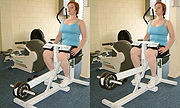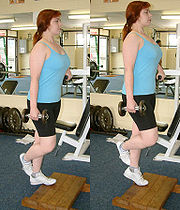
Calf raises
Encyclopedia
Calf raises are a method of exercising the gastrocnemius, tibialis posterior and soleus muscles of the lower leg. The movement performed is plantar flexion, aka ankle extension.
 Bent-knee calf raises are frequently done in a seated position for comfort. Since the weight of the upper body is rested on the seat, resistance is frequently added. Using bodyweight, one leg could be draped across the other (through external rotation) to exercise unilaterally and double the weight lifted.
Bent-knee calf raises are frequently done in a seated position for comfort. Since the weight of the upper body is rested on the seat, resistance is frequently added. Using bodyweight, one leg could be draped across the other (through external rotation) to exercise unilaterally and double the weight lifted.
It can also be executed by using a weight, such as a barbell, to provide resistance to the action of the calf muscles. The exercise is performed from a seated position while the weight rests on the upper leg, just above the knee. The person engaged in this exercise lifts the weight by pushing down on the balls of the feet.
Due to the discomfort of higher weights on a bar, barbells used for seated calf raises are frequently padded or wrapped in a towel. There are also seated calf raise machines designed using levers that have pads built into them to protect the patella, quadriceps and tendons.
Bridging
Bridging exercises are done with a flexed knee to lessen the stretch on the hamstring (a knee flexor) and focus the hip extension work on the gluteus maximus. In that same respect, the reduced knee flexion makes plantar flexion work comparable to a seated calf raise, due to the lessened stretch on the gastrocnemius (like the hamstring, also a knee flexor).
Since the pelvis is in the air, its weight can be shifted onto the feet allowing greater resistance.
This is an awkward exercise due to the reduced stability and difficulty in adding resistance. If one were to raise a leg, the necessity of the arms to avoid falling sideways would often by necessary. If one were to place a padded barbell on the upper quadricep to add resistance, this would make the arms less able to stabilize, requiring core stabilization.
 Standing calf raises are executed with one or both feet. They are frequently done on a raised surface with the heel lower than the toes to allow a greater stretch on the working muscles. The exercise is performed by raising the heel as far as possible. Weights or other methods of providing resistance are commonly used, but the exercise is also effective with body weight alone.
Standing calf raises are executed with one or both feet. They are frequently done on a raised surface with the heel lower than the toes to allow a greater stretch on the working muscles. The exercise is performed by raising the heel as far as possible. Weights or other methods of providing resistance are commonly used, but the exercise is also effective with body weight alone.
Balance may become a difficulty with free-standing calf raises, especially with one-legged variations. Due to this, it is common to hang on to something or lean the hand against a wall for stability. They are also performed using Smith machine
s or using machines specially designed for calf raises with padded anchors for the weight that rest on the shoulders.
machine. The sled is kept nearly locked out and the exerciser is meant to keep the hip and knee joints immobile. This is not a bodyweight exercise, the only body part actually being lifted is the small weight of the foot. The resistance comes from the sled.
A leg press is easy to stabilize and the safety bar is kept in place so if the person can not lift it, it should come down safely.
Category:CalfCategory:Weight training exercises
Bent-knee
Calf raises are sometimes done with a flexed knee, usually roughly 90 degrees. This lessens the stretch in the gastrocnemius (a knee flexor), so the movement is done to emphasize the soleus.Seated

It can also be executed by using a weight, such as a barbell, to provide resistance to the action of the calf muscles. The exercise is performed from a seated position while the weight rests on the upper leg, just above the knee. The person engaged in this exercise lifts the weight by pushing down on the balls of the feet.
Due to the discomfort of higher weights on a bar, barbells used for seated calf raises are frequently padded or wrapped in a towel. There are also seated calf raise machines designed using levers that have pads built into them to protect the patella, quadriceps and tendons.
BridgingBridge (exercise)Bridge is an exercise. Many variations of this exercise are employed throughout the world, most commonly the balancing of the body on the head and feet. Hands are occasionally used instead of or along with the head. It is effective in improving lower back strength...
Bridging exercises are done with a flexed knee to lessen the stretch on the hamstring (a knee flexor) and focus the hip extension work on the gluteus maximus. In that same respect, the reduced knee flexion makes plantar flexion work comparable to a seated calf raise, due to the lessened stretch on the gastrocnemius (like the hamstring, also a knee flexor).Since the pelvis is in the air, its weight can be shifted onto the feet allowing greater resistance.
This is an awkward exercise due to the reduced stability and difficulty in adding resistance. If one were to raise a leg, the necessity of the arms to avoid falling sideways would often by necessary. If one were to place a padded barbell on the upper quadricep to add resistance, this would make the arms less able to stabilize, requiring core stabilization.
Straight-knee
Pushing with the foot with a straighter knee (though for safety it is usually not locked out) stretches the gastrocnemius more, these movements incorporate it better. The soleus still contributes, usually allowing people to lift more weight.Standing

Balance may become a difficulty with free-standing calf raises, especially with one-legged variations. Due to this, it is common to hang on to something or lean the hand against a wall for stability. They are also performed using Smith machine
Smith machine
The Smith machine is a piece of equipment used in weight training. It consists of a barbell that is fixed within steel rails, allowing only vertical movement. New variations allow a small amount of forward and backward movement. A Smith machine often includes a weight rack in the base to help...
s or using machines specially designed for calf raises with padded anchors for the weight that rest on the shoulders.
Leg press
A straight-knee calf raise is often done using the leg pressLeg press
The leg press is a weight training exercise in which the individual pushes a weight or resistance away from them using their legs. The term leg press also refers to the apparatus used to perform this exercise...
machine. The sled is kept nearly locked out and the exerciser is meant to keep the hip and knee joints immobile. This is not a bodyweight exercise, the only body part actually being lifted is the small weight of the foot. The resistance comes from the sled.
A leg press is easy to stabilize and the safety bar is kept in place so if the person can not lift it, it should come down safely.
Exercise notes
It is not uncommon to hear of some fitness trainers using reps of 50 or more, though it has been argued that reps beyond 15 - 20 accomplish little in the way of muscular benefit. The gastrocnemius is composed of fast twitch fibers which benefit from higher weights and lower repetitions.External links
Category:CalfCategory:Weight training exercises

